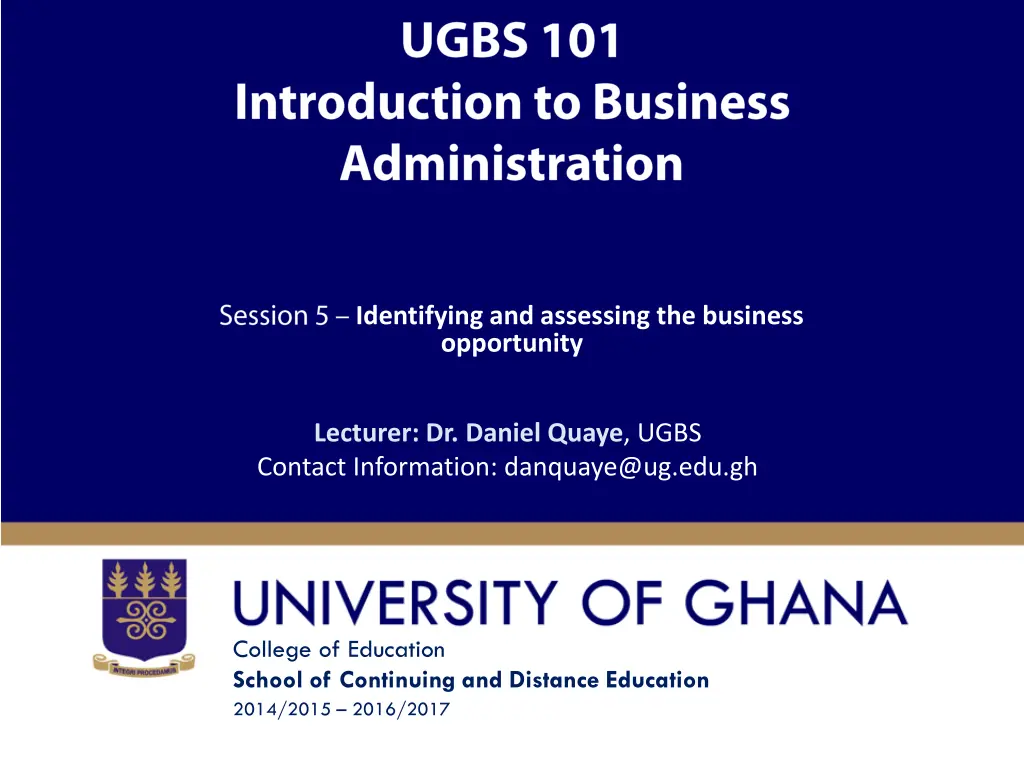
Understanding Business Opportunities: Key Factors and Assessment
Learn from Dr. Daniel Quaye at UGBS about the characteristics of a good business opportunity, including real demand, return on investment, competitiveness, and more. Discover how to identify and assess business opportunities effectively.
Download Presentation

Please find below an Image/Link to download the presentation.
The content on the website is provided AS IS for your information and personal use only. It may not be sold, licensed, or shared on other websites without obtaining consent from the author. If you encounter any issues during the download, it is possible that the publisher has removed the file from their server.
You are allowed to download the files provided on this website for personal or commercial use, subject to the condition that they are used lawfully. All files are the property of their respective owners.
The content on the website is provided AS IS for your information and personal use only. It may not be sold, licensed, or shared on other websites without obtaining consent from the author.
E N D
Presentation Transcript
Identifying and assessing the business opportunity Lecturer: Dr. Daniel Quaye, UGBS Contact Information: danquaye@ug.edu.gh College of Education School of Continuing and Distance Education 2014/2015 2016/2017
1. What is a Business Opportunity? An attractive idea or proposition that provides the possibility of a return for the investor or the person taking the risk. Such opportunities are presented by customer requirements and lead to the provision of a product or service which creates or adds value for its buyer or end-user. Slide 2 Dr. Daniel Quaye, UGBS
2. Characteristics of a good business opportunity For a business opportunity to be good it must fulfill, or be capable of meeting the following criteria: Real demand respond to unsatisfied needs or requirements of customers who have the ability to purchase and who are willing to exercise that choice. Return on investment - provide durable, timely and acceptable returns or rewards for the risk and effort required. Slide 3 Dr. Daniel Quaye, UGBS
Cont. characteristics Competitive- be equal to or better (from the viewpoint of the customer) than other available products or services. Meet Objectives - meet the goals and aspirations of the person or organization taking the risk. Available resources and skills - be within the reach of the entrepreneur in terms of resource, competency and legal requirements. Slide 4 Dr. Daniel Quaye, UGBS
3. Identifying and assessing Business opportunities Ideas and opportunities must be screened and assessed for viability once they have been identified or generated. It can make the difference between success and failure. Identifying and assessing business opportunities involves, in essence, determining risks and rewards reflecting the following factors: Slide 5 Dr. Daniel Quaye, UGBS
Cont. identifying Industry and market Is there a market for the idea? Are there any customers people with money who are able and willing to buy the product or service? Length of the window of opportunity . Can you create or seize the opportunity whilst it lasts? Slide 6 Dr. Daniel Quaye, UGBS
Cont. identifying Management team Who else will be involved with you in the business? Do they have the experience, know how or other desirable attributes required? Competition Who are the competitors? Do you have something desirable by customers that they do not have? Capital, technology and other resource requirements How much capital, or for that matter technology or other resources are required? Do you have them or could you get them? Dr. Daniel Quaye, UGBS
4. Sources of Business ideas Hobbies/Interests A hobby is a favourite leisure-time activity or occupation. Mass media is a great source of information, ideas and often opportunity. Personal Skills and Experience Over half of the idea for successful businesses come from workplace experiences. Slide 8 Dr. Daniel Quaye, UGBS
Cont. sources Exhibitions Another way to find ideas for a business is to attend exhibitions and trade fairs. Surveys - The needs and wants of the customer, which provides the rationale for a product or service, can be ascertained through a survey. Complaints Complaints and frustrations on the part of customers have led to many a new product or service. Slide 9 Dr. Daniel Quaye, UGBS
Cont. sources Brainstorming It usually starts with a question or a problem statement. For instance, what are the products/services needed in the home today, which are not available? Slide 10 Dr. Daniel Quaye, UGBS
Reading list Introduction of Business Administration Distance Education Manual- Dr Daniel Quaye. Madura, Jeff (2007), Introduction to Business Administration, South-Western College Slide 11 Dr. Richard Boateng, UGBS
